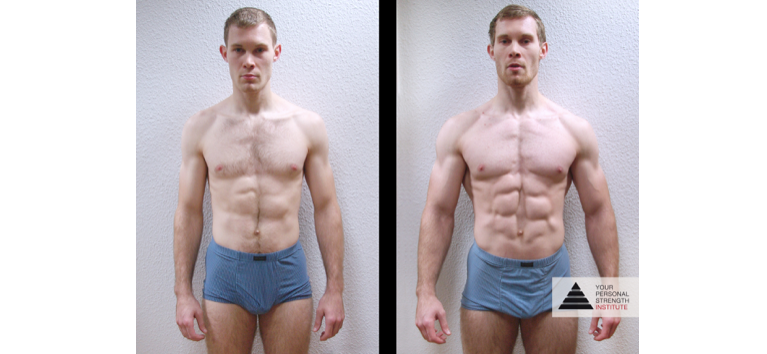Functional Hypertrophy is a term that I often use. The main reason for that is the importance of Functional Hypertrophy for success in strengthtraining. And its importance makes Functional Hypertrophy a cornerstone of my work as a strength coach.
What is Functional Hypertrophy?
The term consists of two words whose definitions based on the Cambridge dictionary are:
Functional = designed to be practical and useful rather than attractive.
Hypertrophy = the enlargement of a tissue.
In the context of training Functional Hypertrophy basically means that we increase the muscular size while making it practical and useful rather than just attractive.
A great example for hypertrophy without the functional component is a bodybuilding approach to training. In bodybuilding no-one cares about the function and practical use of your musclemass, all one wants is the muscle to be big and well developed. Most have seen the bodybuilder that weighs 135kg and his 6RM on the Close Grip Benchpress is 140kg. 140kg sounds like a decent weight, yet in relation to bodyweight, thats nothing, its like a 80kg male bench pressing 82,5kg. Still the Bodybuilder at 135kg bodyweight will have a high level of muscular development and hypertrophy. Just no strength. Nonetheless Functional Hypertrophy still has an effect and advantage for pure hypertrophy and bodybuilding, more on that later in this article.
A simple indicator of Functional Hypertrophy is the 6RM, thats the weight you can use for 6 repetitions, of an exercise. The greater the 6 RM the greater the development of Functional Hypertrophy. From a functional and a visual standpoint.
How will the back development of a 60kg female or 90kg male look if she or he can deadlift 100kg resp. 220kg for 6 reps?
How will the back development of a 60kg female or 90kg male look if she or he can chin-up +15kg resp. +40kg for 6 reps?
How will the arm development of a 90kg male look if he can Incline Curl 35kg for 6 reps?
How will the glute development of a 60kg female look if she can back Squat 90kg for 6 reps?
Everyone with a high level of training experience will agree on the general answer to this question: It will look great and well developed.
Why is Functional Hypertrophy the foundation of results?
Functional Hypertrophy is an overlooked aspect of training as its basically an in-between of the two most popular approaches to strengthtraining which is bodybuilding and powerlifting.
Functional Hypertrophy has actual been the foundation of the muscular development of the greatest bodybuilders of the past, such as Arnold Schwarzenegger, Franco Columbo, Ronnie Coleman and Jay Cutler. They were all known to be very strong and use this strength in combination with bodybuilding methods to development a muscular pyhsique.
Functional Hypertrophy the foundation of consistent results as it allows much more continuous progress in training.
The effect of Functional Hypertrophy on Maximal Strength
Maximal Strength is defined as the maximal force the neuromuscular system can develop against a high load. „Maximal Strength is the mother of all strength qualities“ as legendary sports scientists Prof. Dr. Dr. Dietmar Schmidtbleicher stated decades ago. And Maximal Strength correlates with hypertrophy, that means the bigger a muscle the greater its potential for maximal strength. A simple example of this is to look at the weight classes and world records in powerlifting. The greater body weight and therefore the hypertrophy the higher the world record and therefore the maximal strength. Functional Hypertrophy allows to build more Maximal Strength.
The effect of Functional Hypertrophy on Explosive Strength
Explosive Strength is defined as the maximal force the neuromuscular system can develop against a moderate load in the shortest time possible. The level of Explosive Strength one can develop is limited by the level of Maximal Strength one has as „Maximal strength is the mother of all strength qualities“ as legendary sports scientists Prof. Dr. Dr. Dietmar Schmidtbleicher stated decades ago. Since Explosive Strength correlates with Maximal Strength it also correlates with hypertrophy, that means the bigger a muscle the greater its potential for explosive strength. The most explosive athletes on this planet such as Sprinters, Bobsled athletes and American Football Players all carry an impressive muscular development and hypertrophy. So a bigger muscle increases the potential for explosive strength. Thats a fact of physics, a bigger car can carry a bigger engine which can potentially create more acceleration, just look at a dragster. Another great realize example of this is to look at the weight classes and world records in Olympic weightlifting. The greater body weight and therefore the hypertrophy the higher the world record and therefore the explosive strength, which is the number one strength quality needed in Olympic Weightlifting. Functional Hypertrophy allows to build more Explosive Strength.
The effect of Functional Hypertrophy on Hypertrophy
One of the key drivers in hypertrophy is the amount of absolute muscular damage, that one can recover from, that is induced through training. And Functional Hypertrophy has a clear positive correlation with that from two direction. First, the bigger a muscle, the more fibers can be activated, fatigued and „damaged“. Second, the stronger a muscle, the greater the average load that can be used in training, the more fibers can be activated, fatigued and „damaged“. Doing 10 sets of 6 reps of the Benchpress with an average of 150kg will lead more fibers can be activated, fatigued and „damaged“, than doing 10 sets of 6 reps of the Benchpress with an average of 50kg. That means a greater level of Functional Hypertrophy will increase the potential to gain more hypertrophy. Thats the reason why the greatest bodybuilder of all-time Arnold Schwarzenegger and Ronnie Coleman were also very strong. Both could deadlift over 300kg and bench over 220kg.
The effect of Functional Hypertrophy on Strength Endurance
Strength Endurance is defined as a maximal effort of about 75 to 120 seconds against a moderate load. Thats is for example 20 repetition of the BB Back Squat at a 3010 Tempo. The greater the load used for these 20 reps, the greater the strength endurance. Which is primarily limited by the maximal strength one has, so statistically someone who has a 1RM in the Back Squat of 200kg will use a greater load for 20 reps, than someone who has a 1RM of 100kg. The second factor is the energy reserve a muscle has. Which is limited by multiple factors that can be generally summed up in the term work capacity. And work capacity correlates positively with hypertrophy on a local muscular level. Ever seen a „small“ Crossfit competitor, either male or female? There are none. Why? Because a decent level of muscular development and hypertrophy is crucial for maximal work capacity especially on a local muscular level and especially in the range of strength endurance which is a maximal effort of 75 and 120 seconds against a moderate load. Thats means the greater the level of Functional Hypertrophy one has the greater the strength and local work capacity and therefore the potential for high levels of Strength Endurance.
The effect of Functional Hypertrophy on Muscular Balance & Injury Prevention
Functional Hypertrophy is one of the two most crucial aspects of injury prevention from a training standpoint. In simple terms, the bigger and stronger the muscle is the lower risk of a tear or injury. Thats why one can rip a piece of toilet paper apart but not the sail of a sailboat.
All this leads to the question: How do you train for Functional Hypertrophy?
That is a simple question which a very complex answer. Program design is a quite complex topic. The goal of this article is to define the term Functional Hypertrophy and give the reader some insight into its benefits. Functional Hypertrophy is nothing new. Its been around as long as strengthtraining has been around. Functional Hypertrophy has been forgotten by most in the last decades though.
To give more insight into a training program for Functional Hypertrophy I have added two examples below. As there is no cookie-cutter approach to program design that will work on everybody. This is one reason why I teach so much on program design during the YPSI Trainer Certification and why also one of the first courses of the YPSI Online Education Platform that will be released soon is a a source of program design. And program design is like learning how to cook. There is never gonna be the point where you have understood every cooking method, every ingredient and were you know every recipe there is. Master the fundamentals first. Then add to it to the height of expertise by applying the fundamentals and understanding the finer details For that one always master the fundamentals first. Just like when one wants to get good a cooking and become a great chef. More on a systems-based approach to program design for strengthtraining in my article „Programs vs. Systems„.
And the most fundamental program design principle for Functional Hypertrophy is to periodize training programs where one phase will be designed to primarily increase strength and then be alternated with one phase that will be designed to primarily increase hypertrophy. A phase can be 1 to 4 weeks and is 3 weeks on average.
As this bridges the gap between the two facets of Functional Hypertrophy which are Maximal Strength and Hypertrophy.
The most simple answer that I can give in regards to the question „ How do you train for Functional Hypertrophy?“ is: Increase your 6RM on the main lifts such as squat, deadlift, benchpress and chin-up.
Thats is how to train for Functional Hypertrophy. Simple, but not easy.
How does a training program Functional Hypertrophy look?
The following training program was one phase of Timo Stein’s development over 2 years that you see in the picture above this article. It was his 19th training phase that used a step loading system combined with a back off set and it looked like this:
Day 1 – Upper Body
A1 Pullup, close, neutral, 6×3,3,2,2,1,6, 4010 Tempo, 120s rest
A2 BB 30° Incline Press, mid grip, 6×6,6,4,4,2,6, 4010 Tempo, 120s rest
B1 Lat Pulldown, pronated, wide grip, 4×8-12, 3011 Tempo, 90s rest
B2 Dips, 4×6-8, 4010 Tempo, 90s rest
Day 2 – Lower Body
A BB Back Squat. 6×6,6,4,4,2,6, 4010 Tempo, 180s rest
B1 BB Ab Rollout, paused, 4×25, 2210 Tempo, 120s rest
B2 45° Backextension, DB in front of your chest, 4×12-15 2012 Tempo, 120s rest
How do you periodize Functional Hypertrophy?
As mentioned above the key to developing Functional Hypertrophy is to periodize training programs where one phase will be designed to primarily increase strength and then be alternated with one phase that will be designed to primarily increase hypertrophy. This called undulating periodization and one of the primary periodization models to use, especially if Functional Hypertrophy is the goal.
Functional Hypertrophy is king.
Functional Hypertrophy is the foundation to achieve many training goals.
Picture: Timo Stein has competed in Ju Jutsu for 12 years on international level, been part of the German Nationalteam and won many tournaments before he has started working with Wolfgang 2 years ago. This picture shows his physical development within these 2 years, where he gained over 12kg of Functional Hypertrophy by increasing his bodyweight from 72kg to 82kg and decreasing his body fat slightly. He now started to train for MMA.

